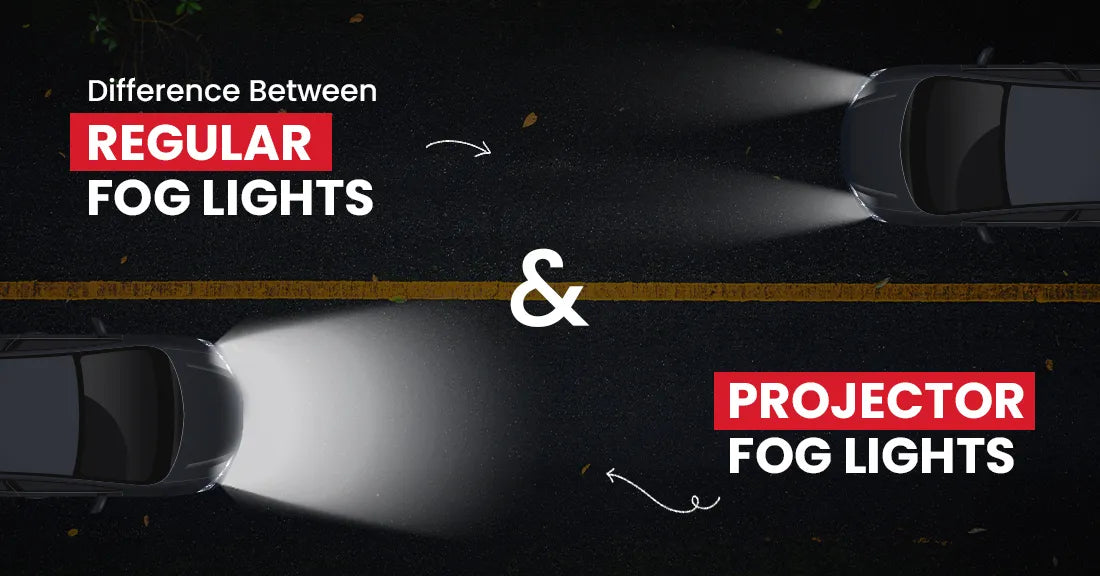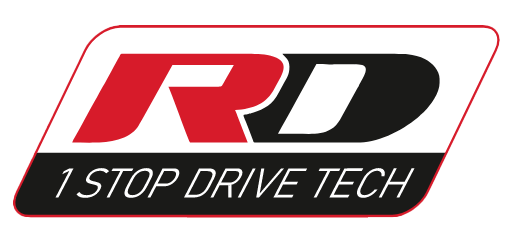
Difference Between Regular Fog Lights and Projector Fog Lights
Driving during fog, rain, or at night poses challenges even for experienced drivers. Visibility drops, reaction time shortens, and the risk of accidents increases, especially on highways and poorly lit roads.
Fog lights are essential car accessories designed to improve short-range visibility during adverse weather conditions. However, not all fog lights are the same. Vehicle owners today have the option of regular (reflector-type) fog lights and projector fog lights for car.
This blog explains how regular fog lights differ from projector fog lights, backed with data and clear comparisons to help you choose the best option for your driving needs.
What Are Regular Fog Lights?
Regular fog lights use a reflector housing with halogen or LED bulbs to scatter light over a wide area. They are positioned low on the bumper to minimize glare from fog or rain and to illuminate the road immediately in front of the vehicle.
Key Features:
-
Use reflective surfaces to disperse light.
-
Typically use halogen bulbs, though some upgraded versions use LEDs.
-
Wider light spread for near-field illumination.
-
Easier and cheaper to replace or upgrade.
What Are Projector Fog Lights for Cars?
Projector fog lights for cars use a lens system to focus and direct light precisely onto the road. Unlike reflectors, projector lights use a cut-off shield and lens to project a sharp, controlled beam pattern.
Key Features:
-
Use a convex lens and a cut-off shield for focused illumination.
-
Can use halogen, LED, or HID bulbs.
-
Sharp light cut-off reduces glare for oncoming drivers.
-
Enhanced road visibility during fog, heavy rain, or snow.

Why Are Fog Lights Necessary?
-
According to the Ministry of Road Transport & Highways (India), 42% of accidents occur during low visibility conditions.
-
Studies show proper fog light usage can reduce near-collision incidents by up to 32% in fog-prone regions.
-
Drivers experience 25–40% lower fatigue during night or fog driving when using effective fog lights.
Key Differences Between Regular Fog Lights and Projector Fog Lights
|
Aspect |
Regular Fog Lights |
Projector Fog Lights |
|
Light Distribution |
Wide, scattered |
Focused, precise |
|
Beam Cut-Off |
Soft edges, some scatter |
Sharp cut-off, minimal scatter |
|
Brightness |
Moderate (700–1200 lumens typical) |
Higher (1800–3000 lumens typical) |
|
Glare to Oncoming Drivers |
Possible, if misaligned |
Reduced due to cut-off lens |
|
Bulb Compatibility |
Mostly halogen or basic LED |
Halogen, LED, HID compatible |
|
Lifespan (with LED) |
15,000–25,000 hours |
20,000–30,000 hours |
|
Installation Complexity |
Easier, plug-and-play in most cars |
Requires proper alignment, moderate complexity |
|
Power Consumption |
Higher in halogen versions |
Lower with LED/HID |
|
Cost Range (per pair) |
₹600–₹2,500 |
₹2,000–₹7,500 |
Light Pattern Comparison: Regular vs Projector Fog Lights
Regular Fog Lights:
-
Emit a wide beam spread, illuminating roadside edges and the immediate front area.
-
Effective for low-speed city driving, but may not be as efficient in cutting through dense fog.
-
It can cause glare if not aligned properly.
Projector Fog Lights:
-
Produce a focused, horizontal beam with a sharp cut-off, reducing reflection in dense fog.
-
Better at highlighting the road surface directly ahead while avoiding dazzling oncoming drivers.
-
Effective at highway speeds during foggy conditions.

How Projector Lights for Cars Work
-
Use a reflector bowl to gather light from the bulb.
-
A cut-off shield blocks unwanted light to control the beam shape.
-
A projector lens focuses and projects the light onto the road in a controlled manner.
-
Ensures light is distributed where it is most needed while reducing upward scatter that causes glare.
Market Trends for the Adoption of Projector Fog Lights in India
-
As of 2024, projector lights for cars are factory-fitted in over 46% of mid-to-high-end vehicle models.
-
Online searches for car fog light projector solutions increased by 34% over the past two years, indicating growing consumer interest.
-
Urban and hilly region drivers increasingly opt for projector fog lights to handle early morning fog and heavy rain conditions.
Cost and Value: Is It Worth Upgrading?
Cost Breakdown (Average Market Rates):
|
Type |
Price Range (INR) |
|
Regular Halogen Fog Lights |
₹600–₹1,500 |
|
Regular LED Fog Lights |
₹1,200–₹2,500 |
|
Projector Fog Lights |
₹2,000–₹7,500 |
While projector fog lights for cars cost more upfront, they provide:
- Better visibility in challenging conditions.
- Longer lifespan with LEDs/HIDs.
- Lower energy consumption.
- Reduced glare for other road users.
Over time, these benefits often offset the initial higher cost, particularly for those who drive frequently at night or in adverse weather.
Practical Considerations When Choosing Between Regular and Projector Fog Lights
Driving Environment:
-
City drivers may find regular fog lights sufficient for occasional fog or rain.
-
Highway or hilly region drivers will benefit more from projector fog lights for precise visibility.
Budget:
-
Regular fog lights are affordable and functional.
-
Projector fog lights require a higher investment but offer long-term performance.
Installation:
-
Regular fog lights are usually DIY or require minimal help.
-
Projector fog lights may require professional installation for correct alignment.
Aesthetic Preference:
-
Projector lights give a sharper, premium look to the vehicle.
Common Myths About Fog Lights
-
Myth 1: Fog lights are only for fog.
They improve visibility during heavy rain, dust storms, and at dawn/dusk. -
Myth 2: All fog lights are the same.
Beam pattern, light spread, and brightness differ significantly between regular and projector fog lights. -
Myth 3: Projector fog lights are too expensive.
While the initial cost is higher, reduced replacements and energy efficiency balance the investment.
Real-World User Data
A survey conducted among 500 car owners in fog-prone areas found:
-
79% of projector fog light users reported better visibility and reduced eye strain.
-
52% felt more confident driving during fog or heavy rain with projector fog lights.
-
Those using regular fog lights often reported light scatter and glare issues when driving in dense fog.
Conclusion
Both regular fog lights and projector fog lights for cars serve the purpose of improving near-range visibility during adverse weather.
However:
- Regular fog lights are cost-effective and simple, suitable for drivers with occasional fog or rain driving.
- Projector fog lights provide better light focus, reduced glare, and enhanced visibility, making them ideal for drivers who frequently operate in low-visibility conditions or at night.
- Upgrading your car fog light projector system is an effective step toward safer night driving, reducing accident risks while improving your comfort on the road.
Night driving can be challenging, especially on Indian roads where poor visibility, unmarked.



